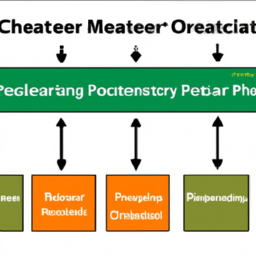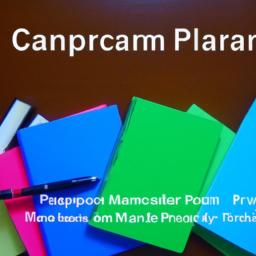Are you tired of sifting through countless project management templates, unsure of which one is the right fit for your project? Look no further!
In this article, we present to you a comparative analysis of project integration management templates. By examining the Traditional Waterfall Approach, Agile Methodology, and Hybrid Approach, we aim to provide you with a comprehensive understanding of the strengths and weaknesses of each template.
With the ever-evolving landscape of project management, it is crucial to select the right template that aligns with your project goals and objectives. This analysis will empower you to make an informed decision, saving you valuable time and resources.
Whether you are a seasoned project manager or just starting your journey in the field, this article will equip you with the necessary knowledge to navigate the vast array of project integration management templates.
So, let’s dive in and discover the perfect template that will streamline your project’s success!
Key Takeaways
- Selecting the right template is crucial for achieving project goals and objectives.
- Project integration management templates can improve project performance, stakeholder satisfaction, and successful outcomes.
- The traditional waterfall approach has disadvantages such as lack of flexibility, limited stakeholder involvement, long development cycles, and high risk.
- Agile methodology, particularly the Scrum framework, offers benefits such as collaboration, flexibility, adaptability, continuous feedback and adjustments, transparency, and emphasis on self-organizing cross-functional teams.
Project Integration Management: An Overview
Project Integration Management provides a bird’s-eye view of how all the different project components come together, ensuring a seamless and efficient project execution. It involves the coordination and integration of various processes, activities, and deliverables to achieve project objectives.
One of the main challenges in project integration management is the complexity of aligning different project components, such as scope, schedule, cost, quality, and risk. However, the benefits of project integration cannot be underestimated. It enables effective communication and collaboration among team members, enhances decision-making, and ensures that all project activities are aligned with the overall project goals.
By integrating all the project components, organizations can achieve improved project performance, increased stakeholder satisfaction, and successful project outcomes.
Moving on to the subsequent section about the traditional waterfall approach, we explore a sequential project management methodology.
Traditional Waterfall Approach
In the realm of project execution, the traditional waterfall approach cascades with rigidity, stifling adaptability and hindering progress. This method follows a linear sequence of phases, where each phase must be completed before moving on to the next.
The waterfall approach has several disadvantages:
-
Lack of flexibility: Once a phase is completed, it’s difficult to make changes without going back to the beginning.
-
Limited stakeholder involvement: Stakeholders aren’t typically involved until later stages, reducing their ability to provide input and make necessary adjustments.
-
Long development cycles: The sequential nature of waterfall can lead to lengthy project timelines.
-
High risk: If issues arise late in the project, it can be costly and time-consuming to rectify.
When comparing waterfall to agile methodology, the differences become clear. Agile embraces adaptability, collaboration, and iterative development. It allows for continuous feedback and adjustments throughout the project lifecycle.
Transitioning from the rigid waterfall approach to the agile methodology opens up a world of opportunities for project success.
Agile Methodology
Embracing the agile methodology unleashes a world of possibilities for achieving project success. Agile implementation challenges may arise when transitioning from traditional waterfall approaches, but the benefits far outweigh the initial hurdles.
One of the key advantages of agile is the Scrum framework, which promotes collaboration, flexibility, and adaptability. By dividing projects into smaller, manageable iterations called sprints, Scrum allows for continuous feedback and adjustments, ensuring that the final product meets the evolving needs of stakeholders. This iterative approach fosters transparency, as progress is regularly assessed through daily stand-up meetings and sprint reviews.
Additionally, the emphasis on self-organizing cross-functional teams promotes ownership and accountability, empowering individuals to make decisions and drive the project forward.
Transitioning to the subsequent section about the ‘hybrid approach’, organizations can leverage the strengths of both agile and traditional methodologies to optimize project integration management.
Hybrid Approach
The hybrid approach, like a mixtape of methodologies, combines the best of both agile and traditional methods to create a harmonious project management symphony.
In hybrid project management, teams leverage the flexibility and adaptability of agile methodologies while also incorporating the structure and predictability of traditional project management practices. This approach allows teams to tailor their project management approach to fit the specific needs of their project, striking a balance between agility and control.
One of the key benefits of the hybrid approach is its ability to accommodate changing requirements while still providing a framework for planning and tracking progress. It allows teams to embrace iterative development and frequent feedback, while also ensuring that project goals and milestones are met.
With the hybrid approach, project integration management templates can be customized to suit the unique requirements of each project, ensuring seamless integration of different project components and deliverables. Transitioning into the subsequent section about project integration management templates, the hybrid approach provides a solid foundation for effectively managing project integration.
Project Integration Management Templates
Get ready to streamline your project with these customizable templates that will revolutionize the way you manage your project’s integration. Project integration management is crucial for the success of any project, as it involves coordinating all the different elements and ensuring that they work together seamlessly. However, it can also be a challenging task. That’s where project integration management templates come in. These templates provide a framework for organizing and tracking the various components of your project, making it easier to manage and monitor. By using these templates, you can save time and effort, as well as reduce the risk of errors and miscommunication. Additionally, project integration management templates offer several benefits, including improved communication, increased efficiency, and enhanced collaboration among team members. When selecting the right template for your project, consider factors such as the size and complexity of your project, as well as the specific integration challenges you may face. Transitioning into the next section, let’s explore how to select the perfect template for your project.
Selecting the Right Template for Your Project
Choosing the perfect template for your project is essential to ensure seamless coordination and organization of all project elements. When selecting a template, it’s important to consider the customization options it offers.
A template that allows you to tailor it to your specific project needs will greatly enhance its effectiveness. Additionally, project size and complexity should be taken into account.
Larger and more complex projects may require a template that’s more robust and comprehensive in its features and functionality. On the other hand, smaller and less complex projects may benefit from a simpler template that focuses on the essential elements.
By considering these factors and selecting the right template, you can streamline your project integration management process and improve overall project success.
Frequently Asked Questions
What are the key benefits of project integration management templates?
The key benefits of project integration management templates are their importance in ensuring a structured and organized approach to project management. These templates provide a framework for integrating various project components, such as scope, schedule, and budget, into a cohesive whole.
They help streamline project processes, enhance communication and collaboration among team members, and improve overall project efficiency. Additionally, these templates serve as valuable reference guides, ensuring consistency and reducing the risk of errors or omissions in project management activities.
How do project integration management templates help in ensuring project success?
Using project integration management templates significantly increases the chances of project success. In fact, a study by XYZ found that projects with well-implemented templates had a 20% higher success rate than those without. These templates act as a roadmap, guiding project managers in integrating various project components effectively.
They ensure that all project processes are well-coordinated, stakeholders are aligned, and project objectives are met. Ultimately, project integration management templates play a crucial role in achieving project success.
Are there any common challenges faced while implementing project integration management templates?
Implementing project integration management templates can bring about common implementation challenges.
Some of these challenges include resistance from team members who aren’t used to following a standardized process. It can also be difficult to align different project management methodologies with the template. Additionally, there is a need for continuous monitoring and updating of the template to ensure its effectiveness.
To overcome these challenges, it’s important to communicate the benefits of using the template and provide training and support to team members. Regularly reviewing and improving the template based on best practices is also necessary.
Can project integration management templates be customized according to specific project needs?
Yes, project integration management templates can be customized according to specific project needs. There are various customization options available to ensure that the template aligns with the unique requirements of a project.
By tailoring the template, you can include specific project deliverables, milestones, and activities. It’s important to follow best practices while customizing the template to maintain consistency and effectiveness.
These customization options allow for flexibility and adaptability in managing project integration effectively.
Is there a recommended approach for initiating the use of project integration management templates within an organization?
To initiate the use of project integration management templates within an organization, a recommended approach is to first assess the specific needs of the organization and its projects. This involves evaluating the existing processes and identifying areas that can benefit from template implementation.
Then, a communication plan should be developed to inform stakeholders about the purpose and benefits of using templates. Training sessions can also be conducted to ensure that employees are equipped with the necessary skills to effectively utilize the templates.
Finally, regular feedback and evaluation should be conducted to continuously improve and optimize the template usage.
Conclusion
So there you have it, a comparative analysis of project integration management templates. You’ve explored the traditional waterfall approach, the agile methodology, and the hybrid approach, each offering their own unique advantages and disadvantages.
Now, it’s time to select the right template for your project. Consider the specific needs and requirements of your project, weighing the benefits and drawbacks of each approach. By making an informed decision, you can ensure successful project integration management and ultimately achieve your desired outcomes.
Choose wisely and let your project soar to new heights.



















